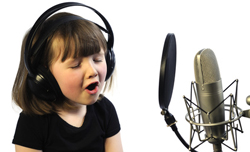 I am a voice-over actor as well as a musician, so Home Brew Audio provides articles and tutorials on both types of recording. Vocal recording for voice-over actors is mostly the same as for musicians but for one thing – there is no music mixed in behind a voice-over recording (at least not usually, and not for long it there is some). So it is that much more important to get the cleanest (least noise) and clearest (best audio quality) recording possible.
I am a voice-over actor as well as a musician, so Home Brew Audio provides articles and tutorials on both types of recording. Vocal recording for voice-over actors is mostly the same as for musicians but for one thing – there is no music mixed in behind a voice-over recording (at least not usually, and not for long it there is some). So it is that much more important to get the cleanest (least noise) and clearest (best audio quality) recording possible.
I found an article on Audiolinks.com yesterday offering 3 microphone tips for voice-over actors. They are good tips, but I wanted to add some things to that post.
The author’s second tip speaks of creating unique tones. He mentions getting closer to the mic to create a deeper sound. This is called “the proximity effect,” and will only work if the mic has a cardioid pick-up (sometimes called “polar”) pattern. Most mics will have that pattern by default, but if you use a multi-pattern mic (my main mic, the Rode NT2-A is one such), you can choose cardioid, figure-8 or omni-directional pickup patterns. So you should be aware that if you are using, say, the “omni” setting, you will not get the proximity effect by moving closer to the mic. By the way, for a review of pickup patterns, see may article Directional and Omnidirectional Microphones – What Are They Good For?
I agree with the “3-tips” tips in the article. But I thought I’d add something about types of microphones. All other things being equal, a voice-over actor should be using a large diaphragm condenser microphone LDC). They typically sound much better than dynamic mics for a variety of reasons (see our article What Are The Different Types of Microphones?). There are some dynamic mics that work well for voice-over, such as the ElectroVoice RE20, which is a very popular broadcast mic. But these are usually more expensive than most LDCs that are excellent for voice-over. The RE20, for example, costs $450.
I did a review of the Audio-Technica AT2035, complete with audio examples, if you’d like to hear what a decent voice-over mic costing $149 sounds like. That post is here: Review of the Audio-Technica AT2035 Microphone.
So enough of my stump-speech. The 3-tips article is here: https://www.audiolinks.com/blog/4-microphone-tips-for-voice-over-actors/
Cheers!
microphones
Lewin's 6 Favorite Microphones For Home Recording
I have my own collection of microphones and my own opinions about what would constitute the top 5-10 mics to use for home recording. But there are a lot of mics out there to choose from and it would be difficult, if not impossible, for anyone to try them all. So it is nice to get a different perspective on these things from time to time.
In my case, I would probably list the Rode NT2-A, Shure SM81, Audio-Technica AT2035, AKG C3000, Sennheiser MKH416, and Oktava MK-319 as great choices for my top 6.
Lewin Barringer put out the below video talking about his 6 favorite mics for home recording, which are very different from the ones on my list. In fact there is not a single mic in common to the two lists.
Anyway, see below for the video from Lewin:
Mics And Loudspeakers For Performing Arts
Live sound isn’t all about long speeches or loud concerts. There are additional considerations and challenges for the performing arts. By treating the performance as its own unique problem with its own set of solutions, you can avoid the headache that is sure to come from trying to mic the gig like a concert.
You can read the full detailed article here: http://www.prosoundweb.com/article/capturing_the_stage_microphone_approaches_for_the_performing_arts/
How To Mic An Acoustic Grand Piano
Getting a great recording from a grand piano starts with mic placement. But with such a large instrument, there are just as many possible problems to run into as potential solutions. As with almost all audio endeavors, taking a little bit of extra time to get a good recording can save you lots more time and heartache later in the process.
You can read the full article about miking a grand piano here: http://www.prosoundweb.com/article/in_the_studio_close-miking_an_acoustic_piano/
Placement Options For Multiple Microphones
Depending on your needs and goals for a recording, there are several different options for mic placement. Using multiple mics can improve the quality of the recording, but even details as small as the angle of the mics in relation to each other can have a significant impact on how the signals received by each mic will sound when played back together.
You can read more here: http://audioundone.com/multiple-microphone-techniques-a-b-placement-x-y-placement-jay-kadis